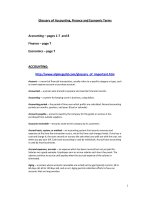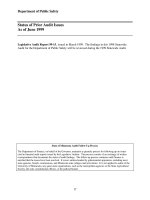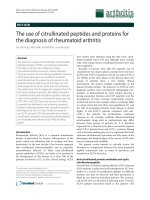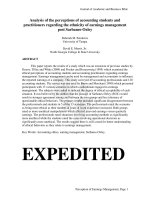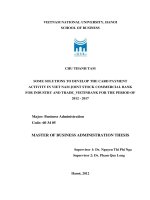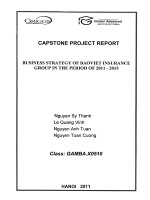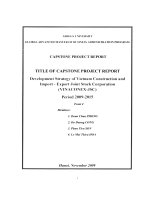Development strategy of saigon college of accounting, finance and informatics for the period 2011 - 2020
Bạn đang xem bản rút gọn của tài liệu. Xem và tải ngay bản đầy đủ của tài liệu tại đây (1.03 MB, 129 trang )
CAPSTONE PROJECT REPORT
DEVELOPMENT STRATEGY OF SAIGON
COLLEGE OF ACCOUNTING, FINANCE
AND INFORMATICS FOR THE PERIOD
2011 - 2020
TUAN TRAN VAN
THAM VO THI TUOI
LIEN DANG THI QUYNH
HANH NGUYEN THI HONG
NHAT THAI HOANG TANG
CLASS: GaMBA01.C0409
Ho Chi Minh City, 2011
2011
GLOBAL ADVANCED MBA PROGRAM (GaMBA01.C0409)
Group No.: 9
GRIGGS UNIVERSITY
GLOBAL ADVANCED MASTER OF BUSINESS ADMINISTRATION PROGRAM
CAPSTONE PROJECT REPORT
DEVELOPMENT STRATEGY OF
SAIGON COLLEGE OF
ACCOUNTING, FINANCE AND
INFORMATICS FOR THE PERIOD
2011-2020
Group Number: 9
Student's name:
TUAN TRAN VAN
THAM VO THI TUOI
LIEN DANG THI QUYNH
HANH NGUYEN THI HONG
NHAT THAI HOANG TANG
CLASS: GAMBA01.C0409
HO CHI MINH CITY. 2011
iii
TABLE OF CONTENTS
Cover………………………………………………………………… i
Acknowledgements….………………………………………………………….……i
Table of contents…………………………………………………………… ……iii
FIGURES AND TABLES
Figure 1.1.4: Strategy formation analysis frame ………………………………………5
Figure 1.1.4.2: EFE matrix …………………….………………………………………6
Figure 1.1.4.3: Competitive image matrix……… …………………………………….8
Figure 1.1.4.4: IFE matrix ……………………………………………………………9
Figure 1.1.4.5: Chart of SWOT matrix ……………………………… ……… …….10
Figure 1.1.4.6: Quantitative Strategic Planning Matrix (QSPM) 11
Table 2.1.1.2. The scale of organization structure………………….………………….17
Table 2.1.1.3: Allocation status of school facilities……………… ………………… 19
Table 2.1.1.4: Industry structure and training fields…………….…………………… 20
Table 2.4.1.5: Policy of tuition fees for special subjects………… ………………….39
Table 3.1.3.1. External factor evaluation matrix (EFE MATRIX)…………………….48
Table 3.1.3.2. Internal factor evaluation matrix (IFE MATRIX)…… ………………49
Table 3.1.3.3. Competitive image matrix…………………………… ……………….55
Table 3.1.3.4. Matrix strengths, weaknesses, opportunities, risks (SWOT
Matrix)………………………………………………………………………………….57
Table 3.1.3.5(A) QSPM Matrix – Group of strategies S – O………….………………62
Table 3.1.3.5(B) QSPM Matrix– Group of strategies W – O………….………………63
Table 3.1.3.5(C) QSPM Matrix – Group of strategies S – T…….……… ………….64
Table 3.1.3.5(D) QSPM Martrix – Group of stratergies W – T….……………………66
Table 3.2.1.1: Orientation of development scope of training forms from 2011 to
2020………………………………………………………………………….…………68
Table 3.2.2.3: Orientation of development of teaching staff from 2011 to 2020…………… 73
Table 3.3.1. Estimate renovate budget,facilities repair and equipment
complement…………………………………………………………………………….80
iv
Table 3.3.2. Allocation quantity - staff level - Teacher (person)…………… ……… 81
Table 3.4.1a : Analyze the financial situation of the Saigon College of Accounting -
Finance - Informatics through balance sheet in 2009, 2010……………………… …86
Table 3.4.1b Results of business activities in 2009, 2010…………………….……….87
Table3.4.1c: The basic financial indicators…………………………… …………… 88
Table3.4.2: The total estimated cost of investment………………… ……………… 90
Table 3.4.3.2-a: Turnover of the project over the years……………………………… 91
Table 3.4.3.2-b: Depreciation of property details………………… …………………93
Table 3.4.3.2-c: Theoretical break-even point……………………… ……………….94
Table 3.4.3.2-d: Business result…………………………………… …………………95
Table 3.4.3.2-e: Table of debt payment schedule…………………… ……………….95
Table 3.4.3.2-f : Debt payment source analysis……………………………………… 96
Table 3.4.3.2-g: Flow of currency analysis………………………… ……………… 97
Table 3.4.3.3 One-way sensitivity and two-ways sensitivity of project ………………98
INTRODUCTION
Chapter 1. Theoretical Basic……………………………………………………… 3
1.1 Overview on the business strategy ……………………………………….… 3
Concept of the strategy …………………………………………………… 3
Roles of the strategic administration ………………… ……………………3
Types of strategy …………………………………………………………….4
Process of setting up the business strategy ………………………………… 5
Training demands and actual situations in Viet Nam ……………………… 13
1.3 The necessity in planning development strategy of Saigon College of
Accounting Finance informatics……………………………………………………13
Chapter 2 Analysis of impact factors affecting development Strategy of Saigon College
of Accounting Finance Informatics(Period of 2010 – 2020)….……………… …… 16
2.1 Introduction of Sai Gon College of Accounting Finance informatics ……… 16
v
2.2 Analysis of macro environment affecting development process of Saigon
College of Accounting - Finance - Informatics – Opportunity and challenge
indentity ………………………………………… ……………………………… 22
2.2.1 Context of Economic – politics .…………………….………………….……22
2.2.2 Social factors ……………………………………… ……………………….29
2.2.3 Science elements - technology …………………………………………… 32
2.2.4 Environmental factors ……………………………………………………….32
2.2.5 Analysis of strong and weak points, opportunities and challenges to
occupational education …………………………………………………………….33
2.3 Analysis of micro environment that affects to the development of Saigon
College of Accounting Finance Informatics - Identify opportunities and challenges
……………… 33
2.3.1 Sector management of the Ministry of Education and Training .….……… 37
2.3.2 Competitive schools in the same sectors ….….……………………….…… 37
2.3.3 The development of local economy ………….……………… …………… 38
2.4. Analyzing the internal environment that affects to the development of the
School, identify strengths and weaknesses through matrixie .…… …………… 38
2.4.1. Analyzing the internal environment….………………… …………………38
2.4.2. Evaluating the strengths - weaknesses ………………………….………… 40
Chapter 3: Strategies build up and solutions for the deverlopment of Saigon College of
Accounting Finance Informatics (Period of 2010 – 2020)
3.1 Build up strategy 44
3.1.1 The basis of strategic orientation 44
3.1.2 General strategic direction 45
3.1.3 Set up strategy for choosing 47
3.2 Specific solutions for execution of strategies 68
3.2.1 Regarding the strategy of market development 68
3.2.2 Regarding the strategy of human resources development… 69
vi
3.2.3 Business strategy 79
3.3 Action programs for execution of strategies 79
3.3.1 Program 1: Investment in upgrading, rehabilitation and expansion of the
school 79
3.3.2 Program 2: To consolidate the development team of managers, teachers 80
3.3.3 Program 3: Open new Branches training 82
3.3.4 Program 4: Student 83
3.3.5 Program 5: School trademark promotion 83
3.3.6 Program 6: Joint training - to promote research and application of science -
technology in training and community serve… 84
3.4 Financial plan for the development strategy… 86
3.4.1 The financial situation of Saigon College of Accounting Finance-
Informatics 86
3.4.2 Estimate Budget for developing strategy in the period 2011-
2020 89
3.4.3 Economic efficiency of projects… 90
3.5 Evaluates the socio-economic result and effect of strategic development
program 99
3.6 Implements the schedule 100
3.6.1 Implementing route 100
3.6.2 Assign tasks…………… …… …… 101
REFERENCES 103
APPENDICES
APPENDICE 1. Form opinions of teacher evaluation……………………………104
APPENDICE 2. Form opinions of student assessment……………………… …107
APPENDICE 3. Form opinion of specialist………………………….…….…… 110
APPENDICE 4. Form opinion of internal Specialists… ………………… ……113
vii
APPENDICE 5. The sum expert opinion about the importance of macro factors
affecting the development of school….………………………………… ………117
APPENDICE 6. The sum expert opinion about the importance of micro factors
affecting the development of school……………………….…………… ………119
APPENDICE 7. The sum expert opinion about the possible reaction of the school in
the competitive factor…………………………………………………………… 121
MGMT 689 – Strategy Management
1
INTRODUCTION
With the great development of the Science and technology, especially the IT and
communication, the human beings is approaching to knowledge based economy in
the orientation of rapid globalization all over the world.
Socio- economic development strategy 2001 – 2010 referred in the Party Congress
IX (4/2001 ) which posed the general target “ To lead out country get rid of less
developed situation, successfully improving the material and spirit life of the
people, to create the fundamental by 2020, our country basically become an
modernization based industrialization country”. For this purpose, education
development is considered as the fundament and motive of the industrialization,
modernization, as a condition for bringing the human resource into full play. To
implement the said requirements, the No. 500/TTg dated 8
th
July 1997 was
promulgated by the Prime Minister on establishing the Vietnam’s education –
training development strategy of by 2020 showed that the socio-economic
development strategy and the human resources and education development strategy
is related dialectically. Pushing up the target of industrialization, modernization
largely depends on the success level of human resources, in which the strategy plays
important role.
To meet this requirement, in a common direction of the Education – Training
Sector, over the past year, Sai Gon College of Accounting, Finance and Informatics
(SAFI) has non stop developed its scope and improved the quality of training the
qualified labor sources positively supplying the technical labor source for the
country. In a dynamic and much variable economy as present, in order to set up,
implement and access the decisions related to many functions allowing the College
to meet the general requirements of the whole branches, simultaneously to meet the
development planning target of the college, we establish a development target of Sai
Gon College of Accounting, Finance and Informatics for period of 2010 – 2020.
MGMT 689 – Strategy Management
2
The building a strategy for education unit is not simple work, as the final result of
the development is not merely to achieve the profit but also as a factor of
contributing to the society. Moreover, the final product of the training process is
trained people who can meet the particular characters of the current time of science
and technology revolutionary happening in global scale, at the same time required
to strategy set up must be appropriate to general instruction of the development
strategy of the whole branch of education – training. With the limited vision, it is
certainly that the strategy is required often amended and completed, it highly
appreciate if the Teachers and all of you to contribute opinions.
MGMT 689 – Strategy Management
3
CHAPTER I: THEORETICAL BASIC
1.1 Overview on the business strategy
1.1.1 Concept of the strategy:
According to the conventional approach, business strategy is the long-term basic
target of an enterprise defined and the action program implemented together with
the necessary resources allocated in order to achieve the set target. It may be
understood that the business strategy is the model being used by the enterprises for
future orientation in order to meet the set targets and maintain the development.
Strategy is defined as aggregate decisions and actions to achieve the goals and
possible to connect the internal forces and external environment of an organization
(According to Prof. PhD. Nguyen Loc – Vietnam Institute of Educational sciences)
This means the strategy must be always assist the organization to achieve its set
goals.
Each organization is required to set up fundament for future success, at the same
time, make effort to excess its vitals in the international competitive arena. In
present business environment, the speed and level of the variations which affects on
the organizations are rapidly increase, it is required that organization to be sensitive,
and adaptable to such variation in order to exist and develop. The strategic
administration process for the purpose of the set goals allows organizations to be
adaptable effectively to the long-term changes.
1.1.2 Roles of the strategic administration:
Strategy helps an Organization to understand better about the current changes as
well as potential changes, as leverage can be used by such organization to create
advantage for itself:
MGMT 689 – Strategy Management
4
To help the organization to define its mission and goals, select orientation to
meet such goals, and to define its scope, position during the performance.
The organization can understand the competitive situation, recognize
opportunities, threats and strengths, weakness in order to grasp such opportunities
and minimize the threats, and allow the organization to define its original, distinct
values in the competitive context.
To help the organization to make decisions on the existence and development
appropriate to available competences and efforts in future.
1.1.3. Types of strategy:
Analysis and valuation of the factors allow the college to combine to select many
strategies. Depending on scope of the strategy, it may be selected the following
strategies:
1.1.3.1 .Based on the strategy scope:
General strategy (overview strategy): referring the most important matters,
most covering and long term significant, and vital to the college.
Part strategy: is the strategy to solve each internal matter ( scale development
strategy, enrollment strategy, trade mark advertisement strategy, etc,)
1.1.3.2. Based on the market approaching:
The strategy focuses on key factors, the human resource not spread widely.
The strategy based on the relative advantage based on the competitive
advantage between the college and its rivals.
Creative strategy looking at the matters to discover new training fields.
MGMT 689 – Strategy Management
5
The strategy exploiting the ability to find out the key factors.
1.1.3.3. Based on the importance of the strategy:
Intensive strategy in the reality: The market development strategy, market
penetration strategy, product development strategy.
Enlarging strategy in the reality: Unanimous diversified strategy combined
diversifying strategy, horizontal diversified strategy.
Business strategy combined in the reality: Strategy combine forward,
combined backward, combined in horizontal direction, combined in vertical
direction.
Other strategies: joint venture strategy, narrowing the operation, liquidating
or mixed strategy.
1.1.4. Process of setting up the business strategy
Business strategy is set up based on the result from analysis of the business
environment to understand and grasp the opportunities and threats, and valuate the
internal business situations to draw the strengths and weakness of the enterprise.
Important techniques to form a strategy may be stated in a process of making
decision including 3 stages, namely: (1) inputting stage; (2) combining stage; (3)
deciding stage [4]. Strategy formation analysis frame is shown in (Figure 1.2)
Figure 1.1.4: Strategy formation analysis frame
STAGE 1: INPUTTING STAGE
External factor evaluation
(EFE)
Matrix of competitive
images
Internal factor evaluation
(IFE)
STAGE 2: COMBINING STAGE
MGMT 689 – Strategy Management
6
Matrix of
Boston
consulting
Group (BCG)
Matrix of
strategy
position and
action
evaluation
(SPACE)
Matrix
SWOT
Internal –
External
matrix (IE)
Matrix of main
strategy
STAGE 3: DECIDING STAGE
Quantitative strategy planning matrix (QSPM)
Source: Nguyen Thi Lien Diep & Pham Van Nam (2006), Business strategy and
Policy Socialist Labor Publishing House, Ho Chi Minh City
1.1.4.1. Inputting stage:
Including analysises of External factors evaluation matrix (EFE); Internal Factors
evaluation matrix (IFE); and competitive image matrix. The purpose of this stage is
to summarize the basic necessary information for forming the strategies.
1.1.4.2. External factors evaluation matrix (EFE).
It allows the strategist to summarize and evaluate the socio- economic, cultural,
demographic, geographic, political, legal, technological and competitive
information. It is included 5 steps in developing an External Factors Evaluation
matrix (EFE).
Figure 1.1.4.2: EFE matrix
Main external
factors
Important level
CLASSIFICATION
Important points
Factor 1
Factor 2
. . .
MGMT 689 – Strategy Management
7
Factor n
Total
1.00
XX
Source: Nguyen Thi Lien Diep & Pham Van Nam (2006), Business strategy and
Policy Socialist Labor Publishing House, Ho Chi Minh City
Step 1: Make the list of factors (from 10 to 20 factors) playing decisive role to the
enterprise’s success, recognized in the process of checking the external factors.
Step 2: Classify the important level from 0,0 (not important) to 1,0 (Very
important) for each factor. This classification shows the importance of the
respective factor to the success of such business line of the enterprise. Total
classification points of all factors must be equal 1, 0.
Step 3: Classify from 1 to 4 for each factor deciding the success in order to indicate
the way that the enterprise’s current strategy reacts to such factor, in which: 1- less
reactive; 2- normal reactive; 3- above average reactive; 4- good reactive.
Step 4: Importance of each variable to its classification to define its points of
importance.
Step 5: Total points for the importance of each variable to define the total points of
the enterprise. Total points that the enterprise may obtain: 4,0 at highest; 2.5 on
average ; and lowest is 1.0. This score is significant to evaluate. The suitable level
of the current strategy that enterprise is applying for the opportunities and threats of
the environment (Figure 1.3)
1.1.4.3. Competitive images matrix
In all events and environmental tendencies, which may affect the enterprise’s
strategy position, affect competition, are often considered the most important. The
competitive images matrix recognizes the main rivals with their strengths,
weakness.
MGMT 689 – Strategy Management
8
Figure 1.1.4.3: Competitive image matrix.
No
Factors
Import
ant
level
DN X
DN X
DN Z
Rank
Importance
points
Rank
Importance
points
Rank
Importanc
e points
1
Factor 1
2
Factor 1
3
. . .
N
Factor n
Total points
1.00
XX
YY
ZZ
Source: Nguyen Thi Lien Diep & Pham Van Nam (2006), Business strategy and
Policy Socialist Labor Publishing House, Ho Chi Minh City
Competitive images matrix is the enlargement of the external factors evaluation in
case of the importance, classification and total importance point have same
significance. The competitive image matrix is different from the external factors
evaluation matrix is that the internal factors plays decisive role to to the
competitiveness of the enterprise such as: financial capacity, competitiveness in the
product price; product quality. Besides, the difference between the two matrixes is
the classification level of the rival companies and their total importance points are
taken into account. The classification levels and the total importance points of these
companies are compared to one sample company [4]. This comparison analysis
supplies the important strategic information (Figure 1.4).
This matrix set up in order to give the evaluation of the company compared to its
rivals in the same branch, which based on the factors affecting the company’s
competitiveness in the same branch. Through which it helps the administrator
recognize the strong points and weakness of the company to the rivals, in order to
define the company’s competitive advantage and disadvantages needs overcoming.
To set up a competitive images matrix, it is required 05 steps:
MGMT 689 – Strategy Management
9
Step 1: Make the list of factors (about 10 factors) playing decisive role to
the company’s competition in the same branch.
Step 2: Classify the important level from 0,0 (not important) to 1,0 (Very
important) for each factor. The importance of each factor depends on the
company’s competitiveness in the same branch. Total important points of all
factors must be equal 1,0.
Step 3: : Classify from 1 to 4 for each factor depending on the company’s
ability to such factor, in which: 4 is very good, 3 is above average, 2 is
average, 1 is weak.
Step 4: Importance of each factor to its classification to define its points.
Step 5: Sum the points of all factors to define the total points of the matrix.
1.1.4.4. Internal factors evaluation matrix (IFE).
IFE matrix is set up is also according to 5 steps as of EFE matrix. However, for the
subjects of enterprises which are studying, analyzing to set up strategy. Total
importance points of the enterprise are defined (equal the total points obtained in
step 4). Total highest points are 4 and lowest is 1, average is 2,5, the important
points lower than 2.5 indicates that the enterprise’s weak internal, higher than 2.5
indicates the enterprise’s strong internal (Figure 1.5)
Figure 1.1.4.4: IFE matrix
Internal factors
Importance level
CLASSIFICATION
Importance
points
Factor 1
Factor 2
. . .
Factor n
MGMT 689 – Strategy Management
10
Total
1.00
XX
Source: Nguyen Thi Lien Diep & Pham Van Nam (2006), Business strategy and
Policy Socialist Labor Publishing House, Ho Chi Minh city
1.1.4.5. Combining stage
In this stage, the most important tool used is SWOT matrix (Figure 1.1.4.5).
Besides, other instruments may be used such as Strategy position and action
evaluation matrix (SPACE); Boston Consulting Group matrix (BCG); Internal –
External (IE); and main strategy matrix to complement the making the feasible
strategy may be selected by arranging the external and internal factors.
Figure 1.1.4.5: Chart of SWOT matrix
SWOT matrix
(of company x)
Opportunity (O)
(List the
opportunities)
Threat (T)
(list the threats )
Strength (S)
(List the strengths of
enterprise
S-O strategy
S-T strategy
Weakness (W)
(List the weakness s of
enterprise )
W-O strategy
W-T strategy
Source: Nguyen Thi Lien Diep & Pham Van Nam (2006), Business strategy and
Policy Socialist Labor Publishing House, Ho Chi Minh city
SWOT matrix is a tool combining Strengths (S), Weakness (W), Opportunity
(O), Threat (T) to form 4 kinds of strategy:
S-O strategy: The enterprise’s Strengths are used to exploit the external
environment’s opportunities.
W-O strategy: The external opportunities are taken advantage to improve
the internal Weakness. These Weaknesses prevent the enterprise from
MGMT 689 – Strategy Management
11
exploiting well such opportunities, therefore, the enterprise needs
overcoming the weakness as soon as possible.
S-T strategy: The enterprise’s strengths are used to avoid or minimize the
external’s threats.
W-T strategy: is defense strategy to minimize the internal weakness and
avoid the external threats.
1.1.4.6. Deciding stage
The information drawn from the inputting stage is used evaluate objectively the
feasible strategies selected in the combining stage. The tool used is Quantitative
strategy planning matrix (QSPM). It indicates the comparative attractiveness of
the strategies which may be selected, and therefore supplying objective basis for
selecting the dedicated strategies.
Figure 1.1.4.6: Quantitative Strategic Planning Matrix (QSPM)
Factors
Import
ance
level
Strategy 1
Strategy 2
Strategy 3
Class
Importa
nt level
Class
Important
level
Class
Important
level
External
factors
Internal
factors
Total
Source: Nguyen Thi Lien Diep & Pham Van Nam (2006), Business strategy and policy,
Society -Labor Publisher, Ho Chi Minh City.
QSPM matrix uses information sources, retrieved from 3 matrixes in the first stage
and 5 matrixes in the second stage to have objective assessemnt of alternative
possoble strategies. The chosen strategies to build QSPM matrix is not to be all
MGMT 689 – Strategy Management
12
strategies, found in the second stage. To form QSPM matrix, we shoud carry out 6
following steps:
Step 1: Listing factors such as S, W, O, T, retrieved from EFE and IFE
matrix
Step 2: Classifying each factor in line with EFE and IFE matrix
Step 3: Researching each matrix in the second stage and defining the
considered strategies.
Step 4: Defining a number of Attraction Points (AS) in line with each fator:
The point is assessed that from 1 to 4 with 1 is not attractive, 2 is a bit of
attraction, 3 is quite attactive and 4 is extremely attractive.
Step 5: Calculated by Total Attraction points (TAS) in line with each row
through multiplying the points, classified in step 2 and a number of AS
points in step 4.
Step 6: Calculating total attraction points of each strategy. The most
attractive strategy is the strategy with total highest points in step 6.
Generally, there are solutions of business strategy, which enterprises can
choose as presented in {1.3.2}. Each strategy can be also applied
independently and connected to carry out other strategies. The progress of
strategy implementation includes 4 following steps: (1) Realizing the current
strategy of the company; (2) Conducting to analyzie the list of investment
capital; (3) Selecting the business strategy; (4) Assessing the selected
strategy. Analyzing subjective and objective factors is essential during the
progress of strategy selection. Importantly, we should consider that the
results of analyzing the list of investment capital is an essential tool, but
which is not the only tool.
MGMT 689 – Strategy Management
13
1.2. Training demands and actual situations in Viet Nam
The socio-economic development strategy in the 2011-2020 is defined with a view
to continuously promoting industrialization and modernization with robust and
sustainable development in order to enhance the strength of the whole nation,
building the country to become an industrialized country under socialism
orientation. The 2011-2015 stage is 5 important years to implement the strategy of
the socio-economic development, the whole country makes efforts to achieve 7 –
7.5% of the average growth in 2015 and about 2000 USD GDP per capita, 17-18%
agriculture, 17 – 18 % industry, 41-42% industry – construction, 41-42% services,
55% the proportion of trained labors (Retrieved in the open speech of the 11
th
Party
Congress by President Nguyen Minh Triet).
Decisive mportance and significance of training and education for the development
movement of the country, emphasized in several documents of the Party and the
Goverment. Training and education development is an important strategy of the
strategy on the socio-economic development. ‚“ Development through education”
is the truth in the current era, which human’s intellectual becomes the precious
resource for the national success in the global fierce competition. In the past time,
education and training has positive changes: The national education system has
been better at all levels, education levels, training levels, eduction types and levels,
increased the scales, especially in higher education and vocational training level,
improved educational social fairness, especially access chances for women and
girls, ethnic minorities, poor and remote areas. The types are getting more and
more various, non-public education models are developed robustly, making
contribution to supplying and training human resource for the national development
movement. Till 9/2009, the whole country has 12.190 kindergartens, 15.051
primary 9.902 elementary secondary schools and 674 elementary high schools, 295
secondary schools, 2192 high schools, 273 vocational schools, 223 colleges, 146
MGMT 689 – Strategy Management
14
universities (The report of Ministry of Education and Training in the 11
th
Party
Congress)
Resource mobilization in the society for education investment through the
socialization policy is quite effective, the above achievements ared state that be the
great contribution of teachers and education management staffs. In addition,
compared to the regulations of the national development, Viet Nam’s education has
existed in insufficient problems, which means that education is not really be the
leading national policy. In spite of being increased financial investment, using
efficience has been not good, management organization of personnel, mechanisms,
policies is slowly innovative with the low education quality, compared to the actual
demands of the society in the integration period; Programs and methods are slow
innovative, not paying attention of creation development of learner’s practice
capacity…But, it is necessary to be more objective when assessing and looking at
defects of basically-based educational methods and basic science with the
applications, not high; focusing on training in under graduate and graduate, but not
paying promptly attention of training workers with the high level, meaning that
lack the synchronous development among education levels and departments,
especially high eduction and university education, vocational training education,
which leads to unreasonble situations in the structure of training level, we are
coping with: In our country, the proportion among people with the university degree
and people with the intermediate level and workers’certificate is 1:1,5:3,5 while the
proportion among regional countries is 1:4:10 ( or 1:5:14). (According to Phan Chu
Trinh Economics and Techniques School, etec.edu.vn/reonline.asp, 03/08/2010), this
proportion is difficult to accept for the robust growing economy.
1.3. The necessity in planning development strategy of Sai Gon College of
Accounting, Finance and Informatics
Viet Nam’s State regards education and training and technological science as the
leading policy; education and training development is considered as the foundation
MGMT 689 – Strategy Management
15
and driving force of industrialization and modernization movement to be a
condition for the improvement of human resource. It is necessary to make
fundamental changes of education and training. Education and training is one of 3
main fields to make a brokenkthough motivation to change the socio-economic
situation. (Documents in the 11
th
Party Congress, Truth Publishe, Ha Noi, in 2011)
Saigon College of Accounting - Finance - Informatics, located in the strategic
economic zone in the south (Ho Chi Minh city, Binh Duong, Dong Nai, Binh
Phuoc, Ba Ria-Vung Tau, Tay Ninh, Long An provinces), being the leading
industrial center of the country, including 56% labor force, 25% trained labors, 15%
skillful labors. This proportion is low, compared to regional countries, which affects
competitive promotion of regional enterprises (The report on analyzing labor
market in Ho Chi Minh city in January, 2011, dated on 01/20/2011)
The reason for lacking skillfull labor resource is mainly caused by training human
resource without planning, imbalanced in vocational training system and structure,
focused on university level, not keeping up with economic restructuring demands.
Moreover, the demands of the youth after finishing the courses of basic education to
prepare for taking part in the labor market; the demand of further education of
labors to change their professtion, labor demand of enterprises and other labors’s
purposes, the demands of researching and applying science and technology to serve
for education and training, and initially the demand of continuing the study of
graduates in all education levels to have a fixed professional job.
Therefore, to meet the urgent demands, Saigon College of Accounting - Finance -
Informatics has made development strategy in the 2011-2010 stage with the scale
development in parallel with promoting the training quality, amking contribution to
the requirements of technical labors for the strategic economic area in the South and
modernization and industrialization movement of the country.
MGMT 689 – Strategy Management
16
CHAPTER 2: OVERVIEW AND ANALYSIS OF IMPACT FACTORS
AFFECTING DEVELOPMENT STRATEGY OF SAI GON COLLEGE OF
ACCOUNTING, FINANCE AND INFORMATICS (PERIOD OF 2010-2020)
2.1. Introduction of SaiGon College of Accounting, Finance and Informatics
2.1.1 The overview of the school – Foundation and development process
2.1.1.1 Foundation history
SaiGon College of Accounting, Finance and Informatics, called as former Sai Gon
Finance – Accounting – Informatics Private School, founded on 11/01/2006 under
Decision No 4886/QĐ – UBND by president People ’s Committee of Ho Chi Minh,
located at 327 Nguyen Thai Binh, ward 12, Tan Binh district, Ho Chi Minh city.
- In 2007, The school opened unit 2 at, Phan Huy Ich road, ward 14, Go Vap
district, Ho Chi Minh city. In 2009, The school opened unit 3 at No 45 Dong Ho,
ward 8, Tan Binh district, Ho Chi Minh city.
- In 2010, the school renamed to be Saigon College of Accounting - Finance -
Informatics. Saigon College of Accounting - Finance - Informatics trains human
resource in departments: Finance, Accounting, Informatics to serve for the domestic
labor demand. In addition, the school has also expanded training link forms with
other universities and colleges as well as organizing certificate classes of languages
and informatics.
Currently, the school has 91 fixed teachers and staffs (including 15% with graduate
degree) with good professional level, education profession, political ideology,
morality and devoted to their profession.
2.1.1.2.Organization structure:
MGMT 689 – Strategy Management
17
Based on organization and operation regulations of non-public schools as
promulgated under Decision No 39/2001/QĐ-BGD&ĐT, dated on 08/28/2001 by
Minister of ministry of Education and Training, SaiGon College of Accounting,
Finance and Informatics was founded with the following organization structure:
Table 2.1.1.2. The scale of organization structure
STT
Organization model
Amount of
people
1
Management Board
03
Representatives of foundation members
02
Representatives of Administration Board
(Principal)
01
2
Board of finance control
02
Representives of foundation members
01
3
Organizations of Party Cell, Labor
Union, Youth Union
03
4
Board of school management
03
Principal
01
Deputy Principal of training
01
Deputy Principal of finance and
infrastructure
01
5
Departments
25
Training and Management Department for
students
Organization – Administation – General
Department
Finance – Accounting Department
6
Faculties
Faculty of Elementary science
Faculty of Informatics
Faculty of Finance and Monetary
Faculty of Accounting
7
School’s workshops
Pratice workshop for Information
MGMT 689 – Strategy Management
18
Technology
Laboratory
Library
Source: The report on organization structure situation of Sai Gon Finance –
Accounting – Informatics in 2011
2.1.1.3. Infrastructure situation:
To well serve teaching and learning tasks of lectures and students, synchronously to
favorable conditions for learning and living, the school has invested in construction:
- Over 4.000 m
2
thepry and practice classrooms to meet the standards and
equipment to meet teaching and learning needs.
- A dormitory with 200 accommodation sites with full facilities and recreation area.
- The school has a main office and 2 units:
+ The main office at 327 Nguyễn Thái Bình, ward 12, Tân Bình district, Hồ
Chí Minh city
+ Unit 2 at 54/9 Phan Huy Ích, ward 14, Gò Vấp district, Hồ Chí Minh city;
+ Unit 3 at 45 Đông Hồ, ward 8, Tân Bình district, Hồ Chí Minh City with a
total area of about 15.000 m
2
and 50 classrooms, 3 computering practice rooms, 2
Laboratories, meeting the demand for 5000 students for learning and researching
and a dormitory with accommodation for 200 students.
